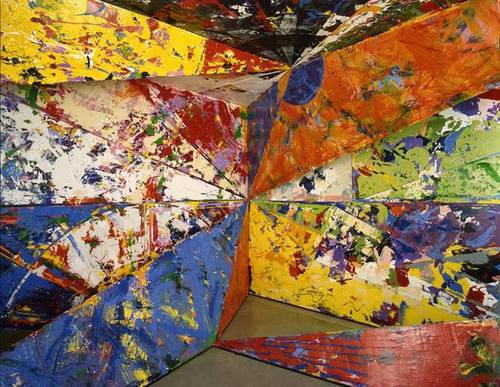Richard Jackson
19 May - 13 Aug 2006
Richard Jackson
Works from the Friedrich Christian Flick Collection at the Hambuger Bahnhof
19 May - 13 August 2006
The development and publication of the Friedrich Christian Flick Collection at the Hamburger Bahnhof will result in diverse exhibition formats over the course of a seven-year agreement. Once a year a thematic exhibition is shown in the Rieck Halls, conceived from the extensive holdings of the collection. Additionally, there are monographic presentations of those artists, whose works the collector acquired in larger accumulations. Following the first solo exhibition dedicated to the Swiss artist Urs Fischer in the summer of 2005, the Hamburger Bahnhof is now presenting the work of Richard Jackson, a California-born artist who lives near Los Angeles, in his first large museum debut in Germany.
Since the 1960s, Richard Jackson has dedicated himself to the spatial and conceptual advancement of painting. The self-professed art anarchist – who received quite a lot of international attention through his participation in the Biennales in Lyon in 1997 and in Venice in 1999 – may indeed work with color and canvas, but painting in a conventional sense is by no means what results. Instead, Jackson makes art about art; his reflections about color, the paintbrush, the process of painting and the painter himself has led to the creation of a body of work, which represents a complex, instinctive, performance-based questioning of the potential of painting and of the phenomenon of time. While rejecting expressive gestures in painting, Jackson allows his droll and stringent parameters, as well as his manual approach, to be confronted by the capriciousness of chance. Reminiscent of Jackson Pollock’s canvases, spaces result from a wall-encompassing style of painting, in which reversed or rotating canvases integrated into the works have served as brushes, for example; or they are created through wildly spraying painting machines.
Numerous of Jackson’s works are located in the Friedrich Christian Flick Collection, which when taken together provide a survey of the most important stages in his artistic development. The exhibition, which iIncludes three of Jackson’s large-scale, key works from the 1980s, and a selection of models and drawings, offers a vividly colorful encounter with sculptures that reveal the artist’s working process, with his installations and performative painting events.
A richly illustrated edition of the newspaper “Museum für Gegenwart”
(Museum for the Present, in German and English) will be published on the exhibition that is to be shown in Hall 3 and the side galleries in the Rieck Halls.
© Richard Jackson, Big Ordeals, 1988
Leinwand, Holz, Acryl
Foto: Paul Hester, Houston
Works from the Friedrich Christian Flick Collection at the Hambuger Bahnhof
19 May - 13 August 2006
The development and publication of the Friedrich Christian Flick Collection at the Hamburger Bahnhof will result in diverse exhibition formats over the course of a seven-year agreement. Once a year a thematic exhibition is shown in the Rieck Halls, conceived from the extensive holdings of the collection. Additionally, there are monographic presentations of those artists, whose works the collector acquired in larger accumulations. Following the first solo exhibition dedicated to the Swiss artist Urs Fischer in the summer of 2005, the Hamburger Bahnhof is now presenting the work of Richard Jackson, a California-born artist who lives near Los Angeles, in his first large museum debut in Germany.
Since the 1960s, Richard Jackson has dedicated himself to the spatial and conceptual advancement of painting. The self-professed art anarchist – who received quite a lot of international attention through his participation in the Biennales in Lyon in 1997 and in Venice in 1999 – may indeed work with color and canvas, but painting in a conventional sense is by no means what results. Instead, Jackson makes art about art; his reflections about color, the paintbrush, the process of painting and the painter himself has led to the creation of a body of work, which represents a complex, instinctive, performance-based questioning of the potential of painting and of the phenomenon of time. While rejecting expressive gestures in painting, Jackson allows his droll and stringent parameters, as well as his manual approach, to be confronted by the capriciousness of chance. Reminiscent of Jackson Pollock’s canvases, spaces result from a wall-encompassing style of painting, in which reversed or rotating canvases integrated into the works have served as brushes, for example; or they are created through wildly spraying painting machines.
Numerous of Jackson’s works are located in the Friedrich Christian Flick Collection, which when taken together provide a survey of the most important stages in his artistic development. The exhibition, which iIncludes three of Jackson’s large-scale, key works from the 1980s, and a selection of models and drawings, offers a vividly colorful encounter with sculptures that reveal the artist’s working process, with his installations and performative painting events.
A richly illustrated edition of the newspaper “Museum für Gegenwart”
(Museum for the Present, in German and English) will be published on the exhibition that is to be shown in Hall 3 and the side galleries in the Rieck Halls.
© Richard Jackson, Big Ordeals, 1988
Leinwand, Holz, Acryl
Foto: Paul Hester, Houston

